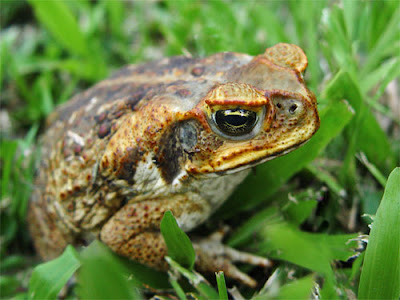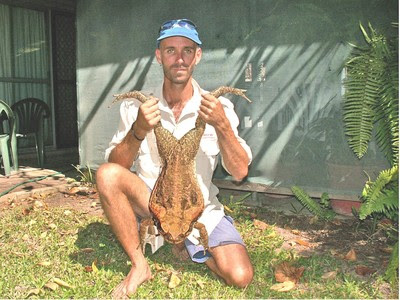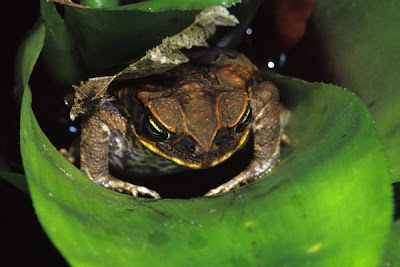Beauty Of Animal | Gray Tree Frog | The Gray Treefrog (Hyla versicolor) or Gray Tree Frog, is a species of small arboreal frog native to much of the eastern United States and southeastern Canada. It is sometimes referred to as the Eastern Gray Treefrog, Common Gray Treefrog, or Tetraploid Gray Treefrog to distinguish it from its more southern genetically disparate cousin, the Cope's Gray Treefrog (Hyla chrysoscelis). It may sometimes be referred to as the North American Tree Frog by Europeans to distinguish it from their European Tree Frog
As the scientific name implies, Gray treefrogs are variable in color owing to their ability to camouflage themselves from gray to green, depending on the substrate they are sitting on. The degree of mottling varies. They can change from nearly black to nearly white. They change color at a slower rate than a chameleon. Dead Gray Treefrogs and ones in unnatural surroundings are predominantly gray. They are relatively small compared to other North American frog species, typically attaining no more than 1.5 to 2 in (3.8 to 5.1 cm).
Their skin has a lumpy texture to it, giving them a warty appearance. They are virtually indistinguishable from the Cope's Gray Tree Frog, Hyla chrysoscelis, the only readily noticeable difference being their calls. Cope's Gray Tree Frog has a shorter, faster call. The Gray Treefrog also has an extra set of chromosomes (4N), or 48 in total, and is called Tetraploid Gray Treefrog in scientific circles. The more southerly Cope's Gray Treefrog, or Diploid Gray Treefrog, retained its 2N (24) original chromosome set, so hybridization between these species would not be successful.
Both Hyla chrysoscelis and Hyla versicolor have bright yellow patches on the hind legs, which distinguishes them from other treefrogs, such as Hyla avivoca. The bright patches are normally only visible while the frog is jumping. Both species of Gray Treefrogs are slightly sexually dimorphic. Males have black or gray throats, while the throat of the female is lighter
Scientific classification
Kingdom: Animalia
Phylum: Chordata
Class: Amphibia
Order: Anura
Family: Hylidae
Genus: Hyla
Species: H. versicolor
Tadpoles have a rounded body (as opposed to the more elongated bodies of stream species) with a high, wide tail that can be colored red if predators are in the system. Metamorphosis can occur in as little as 2 months with optimal conditions. At metamorphosis, the new froglets will almost always turn green for a day or two before changing to the more common gray. Young frogs will also sometimes maintain a light green color and turn gray or darker green after reaching adulthood.
As the scientific name implies, Gray treefrogs are variable in color owing to their ability to camouflage themselves from gray to green, depending on the substrate they are sitting on. The degree of mottling varies. They can change from nearly black to nearly white. They change color at a slower rate than a chameleon. Dead Gray Treefrogs and ones in unnatural surroundings are predominantly gray. They are relatively small compared to other North American frog species, typically attaining no more than 1.5 to 2 in (3.8 to 5.1 cm).
Their skin has a lumpy texture to it, giving them a warty appearance. They are virtually indistinguishable from the Cope's Gray Tree Frog, Hyla chrysoscelis, the only readily noticeable difference being their calls. Cope's Gray Tree Frog has a shorter, faster call. The Gray Treefrog also has an extra set of chromosomes (4N), or 48 in total, and is called Tetraploid Gray Treefrog in scientific circles. The more southerly Cope's Gray Treefrog, or Diploid Gray Treefrog, retained its 2N (24) original chromosome set, so hybridization between these species would not be successful.
Both Hyla chrysoscelis and Hyla versicolor have bright yellow patches on the hind legs, which distinguishes them from other treefrogs, such as Hyla avivoca. The bright patches are normally only visible while the frog is jumping. Both species of Gray Treefrogs are slightly sexually dimorphic. Males have black or gray throats, while the throat of the female is lighter
Scientific classification
Kingdom: Animalia
Phylum: Chordata
Class: Amphibia
Order: Anura
Family: Hylidae
Genus: Hyla
Species: H. versicolor
Tadpoles have a rounded body (as opposed to the more elongated bodies of stream species) with a high, wide tail that can be colored red if predators are in the system. Metamorphosis can occur in as little as 2 months with optimal conditions. At metamorphosis, the new froglets will almost always turn green for a day or two before changing to the more common gray. Young frogs will also sometimes maintain a light green color and turn gray or darker green after reaching adulthood.
Find Here The Kinds Of Animals and Flora and Fauna
Animal Flora and Fauna



















































